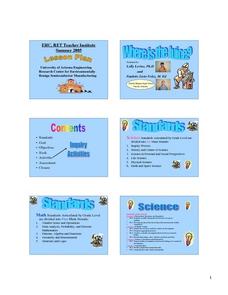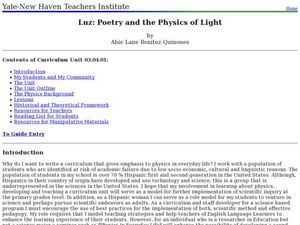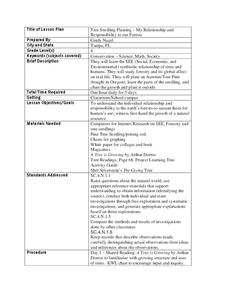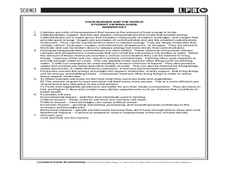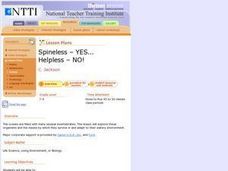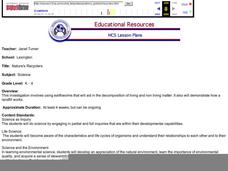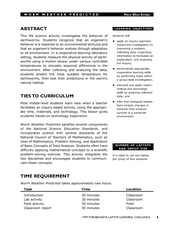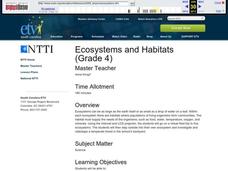Curated OER
How Old Is Mike?
Students examine the absolute dating of fossils, they use a list of names and ages to determine the difference between relative age and absolute age. They explore the relative age and absolute age of people and of fossils.
Curated OER
Plants In Space
In this biology activity, students grow corn plants in growth pouches as the control group in an experiment on plant growth in microgravity. Then they analyze any differences that occur between Earth-grown and space-grown corn plants.
Curated OER
Energy in a Clean Environment
Young scholars identify and describe the different types of energy and how it is transferred. In this energy lesson students complete several activities including how to calculate joules, adding up wattage, and create a presentation on...
Curated OER
All Sorts of Seeds!
First graders compare seeds and explore how they are carried through the environment.
Curated OER
Where Is The Juice?
Students are introduced to the component's of Ohm's Law. In groups, they practice their problem solving skills by reviewing problems solved earlier. They participate in activities that help them gather information on the importance of...
Curated OER
Reading the River - Biological Classification
Youngsters create a list of grocery store items and then work together to categorize them as if they were setting up the shelves of the market. Then they are given a box of miscellaneous objects to practice categorizing. With these two...
Curated OER
Chameleons Are Cool!
Have your learners review what they know about camouflage using this lesson. Learners fill out a graphic organizer listing what they know or have questions about. This could be enhanced with the addition of a writing assignment in which...
Curated OER
On the Microbe Trail: Bacteria and Aseptic Technique
Students pour, label, streak, seal and store plates in an incubator. They identify areas in their environment that provide a rich fauna of microbes once they have been swabbed. They identify areas of contamination through a laboratory...
PBS
Predicting/Making a Hypothesis
As an introduction to the hypothesis and testing method of investigation, young history detectives engage in a special investigation of a family artifact. After watching a short video that demonstrates the method, they develop a...
Curated OER
Designing an Underwater Habitat for Humans
Students consider the limitations of deep water oceanography and design an underwater habitat to support scientists while they complete long term studies under the ocean. In this engineering activity, students are introduced to the...
Curated OER
Luz: Poetry and the Physics of Light
Students explore color, light, refraction and reflection. In this light activity students measure solar position and compare it to time.
Curated OER
Death On Board La Belle: Finding Clues from Old Bones
Students practice analyzing skeletal remains for clues by using the Internet. In this scientific investigation lesson, students research the La Belle shipwreck using the Internet and written materials, later completing a Skeletal Report...
Curated OER
Get Your Motor Runnin'
Students examine the technology of hybrid vehicles and the claims made on their behalf. Upon further exploration, they research and decide which cars, hybrid or non-hybrid, might perform best under various circumstances.
Curated OER
Weather Words
Students brainstorm and define five terms for precipitation, discuss reasons why English language includes various terms for wet weather, and create word games such as jumbles, word searches, or crossword puzzles with weather terms.
Curated OER
Tree Seedling Planting- My Relationship and Responsibility to our Forests
In this trees lesson plan, 4th graders read the book, A Tree is Growing and complete a KWL chart on how trees grow and how they are used. Students research the symbiotic relationship of humans and trees, create tree collages, plant a...
Curated OER
Animal Organs and the Study of Reproduction, Embryology and Cancer
Students examine organs from dogs and cats to study reproduction, embryology, and the identification of cancer. They record their observations at both the gross and microscopic levels. They present their information to the class.
Curated OER
Radiation Reassessed
Young scholars investigate the dangers of radiation by exploring recent nuclear tragedies. In this scientific debate activity, students define the idea of radiation "half life" and determine if low doses of radiation are truly damaging...
Curated OER
Building a Pill Bug Palace
Students make "pets" of isopods (potato bugs) to determine their preferred environment and food sources. They record their results on a bar graph and in a scientific report.
Curated OER
Fast Food: You Can Choose!
Learners research the nutritional value of fast food. They assess which fast foods are best and worst to eat. They organize their data into tables and graphs and explain their findings to other students.
Curated OER
Spineless - YES... Helpless - NO!
Students distinguish between invertebrate and vertebrate organisms while examining the zoological classes of a number of invertebrates. They illustrate a food web of these organisms and investigate the impact of humans on the oceanic...
Curated OER
Nature's Recyclers
Learners create environments to demonstrate how earthworms interact with their surroundings.
Curated OER
Worm Weather Predicted
Students examine worm habitats. In this animal habitats lesson, students participate in a lab activity that requires them to explore the adaptations that earthworms make to their environment.
Curated OER
It All Began With a Bean
Students explore human anatomy by participating in hands-on activities. In this digestive system lesson plan, students read the book It All Began With a Bean and discuss the process of food digestion in our body. Students utilize soda...
Curated OER
Ecosystems and Habitats
Fourth graders go on a virtual field trip to five ecosystems. They investigate and videotape a temperate forest in the school's backyard.






